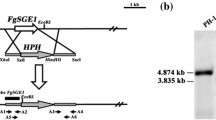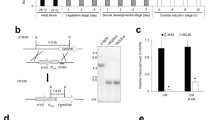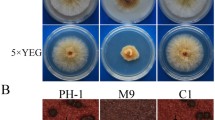Abstract
The target of rapamycin (TOR) signaling pathway plays critical roles in regulating vegetative development and virulence in Fusarium graminearum. Previously, we have demonstrated that the putative type 2A phosphatase FgPpg1, a downstream component of the pathway, is important for hyphal growth, sporulation, DON biosynthesis and virulence. Here, we report the identification of FgHLTF1 putatively encoding a histone-like transcription factor by the transcriptome analysis of an ΔFgppg1 mutant. The FgHLTF1 expression was significantly down-regulated by the deletion of FgPPG1 or treatment with rapamycin. Analysis of an F. graminearum strain expressing green fluorescent protein (GFP) revealed that FgHltf1-GFP fusion protein mainly localized to the nucleus. Targeted gene deletion mutants of FgHLTF1 exhibited a significant reduction in vegetative growth, sexual reproduction and virulence. Moreover, the growth of the ΔFghltf1 mutants was restricted by hyperosmotic stresses. Unlike the wild-type strain, the mutants showed anomalous subcellular translocation of FgHog1-GFP under hyperosmotic conditions, suggesting that FgHLTF1 is associated with the high osmolarity glycerol response pathway. Taken together, we conclude that FgHLTF1 is transcriptionally regulated by the TOR signaling pathway and plays important roles in regulating vegetative growth, sexual reproduction, virulence and hyperosmotic stresses in F. graminearum.








Similar content being viewed by others
References
Baxevanis AD, Arents G, Moudrianakis EN, Landsman D (1995) A variety of DNA-binding and multimeric proteins contain the histone fold motif. Nucleic Acids Res 23:2685–2691
Becker DM, Fikes JD, Guarente L (1991) A cDNA encoding a human CCAAT-binding protein cloned by functional complementation in yeast. Proc Natl Acad Sci USA 88:1968–1972
Bergh K, Litzka O, Brakhage A (1996) Identification of a major cis-acting DNA element controlling the bidirectionally transcribed penicillin biosynthesis genes acvA (pcbAB) and ipnA (pcbC) of Aspergillus nidulans. J Bacteriol 178:3908–3916
Bucher P (1990) Weight matrix descriptions of four eukaryotic RNA polymerase II promoter elements derived from 502 unrelated promoter sequences. J Mol Biol 212:563–578
Cao S, Kumimoto RW, Gnesutta N, Calogero AM, Mantovani R, Holt BF (2014) A distal CCAAT/NUCLEAR FACTOR Y complex promotes chromatin looping at the FLOWERING LOCUS T promoter and regulates the timing of flowering in Arabidopsis. Plant Cell 26:1009–1017
Chen L, Tong Q, Zhang C, Ding K (2018) The transcription factor FgCrz1A is essential for fungal development, virulence, deoxynivalenol biosynthesis and stress responses in Fusarium graminearum. Curr Genet. https://doi.org/10.1007/s00294-018-0853-5
Di CC, Arndt KT (1996) Nutrients, via the Tor proteins, stimulate the association of Tap42 with type 2A phosphatases. Genes Dev 10:1904–1916
Ding M, Li J, Fan X, He F, Yu X, Chen L, Zou S, Liang Y, Yu J (2018) Aquaporin1 regulates development, secondary metabolism and stress responses in Fusarium graminearum. Curr Genet 64:1057–1069
Frendsen RJ, Nielsen NJ, Maolanon N, SØrensen JC, Olsson S, Nielsen J, Giese H (2006) The biosynthetic pathway for aurofusarin in Fusarium graminearum reveals a close link between the naphthoquinones and naphthopyrones. Mol Microbiol 61:1069–1080
Frontini M, Imbriano C, Disilvio A, Bell B, Bogni A, Romier C, Moras D, Tora L, Davidson I, Mantovani R (2002) NF-Y recruitment of TFIID, multiple interactions with histone fold TAFIIs. J Biol Chem 277:5841–5848
Gonzalez S, Rallis C (2017) The TOR signaling pathway in spatial and temporal control of cell size and growth. Front Cell Dev Biol 5:61
Goswami RS, Kistler HC (2010) Heading for disaster: Fusarium graminearum on cereal crops. Mol Plant Pathol 5:515–525
Gu Q, Zhang C, Yu F, Yin Y, Shim WB, Ma Z (2015a) Protein kinase FgSch9 serves as a mediator of the target of rapamycin and high osmolarity glycerol pathways and regulates multiple stress responses and secondary metabolism in Fusarium graminearum. Environ Microbiol 17:2661–2676
Gu Q, Zhang C, Liu X, Ma Z (2015b) A transcription factor FgSte12 is required for pathogenicity in Fusarium graminearum. Mol Plant Pathol 16:1–13
Gusmaroli G, Tonelli C, Mantovani R (2001) Regulation of the CCAAT-binding NF-Y subunits in Arabidopsis thaliana. Gene 264:173–185
Jackson SM, Ericsson J, Mantovani R, Edwards PA (1998) Synergistic activation of transcription by nuclear factor Y and sterol regulatory element binding protein. J Lipid Res 39:767–776
Jiang C, Zhang C, Wu C, Sun P, Hou R, Liu H, Wang C, Xu JR (2016) TRI6 and TRI10 play different roles in the regulation of deoxynivalenol (DON) production by cAMP signalling in Fusarium graminearum. Environ Microbiol 18:3689–3701
Jonkers W, Dong Y, Broz K, Kistler HC (2012) The Wor1-like protein Fgp1 regulates pathogenicity, toxin synthesis and reproduction in the phytopathogenic fungus Fusarium graminearum. PLoS Pathog 8:e1002724
Kim YT, Lee YR, Jin J, Han KH, Kim H, Kim JC, Lee T, Yun SH, Lee YW (2005) Two different polyketide synthase genes are required for synthesis of zearalenone in Gibberella zeae. Mol Microbiol 58:1102–1113
Lemon B, Tjian R (2000) Orchestrated response: a symphony of transcription factors for gene control. Genes Dev 14:2551–2569
Li XY, Mantovani R, Hooft van HR, Andre I, Benoist C, Mathis D (1992) Evolutionary variation of the CCAAT-binding transcription factor NF-Y. Nucleic Acids Res 20:1087–1091
Littlejohn TG, Hynes MJ (1992) Analysis of the site of action of the amdR product for regulation of the amdS gene of Aspergillus nidulans. Mol Gen Genet 235:81–88
Litzka O, Then BK, Brakhage AA (2010) The Aspergillus nidulans penicillin-biosynthesis gene aat (penDE) is controlled by a CCAAT-containing DNA element. Eur J Biochem 238:675–682
Livak KJ, Schmittgen TD (2001) Analysis of relative gene expression data using real-time quantitative PCR and the 2−∆∆CT method. Methods 25:402–408
Lysøe E, Pasquali M, Breakspear A, Kistler HC (2011) The transcription factor FgStuAp influences spore development, pathogenicity, and secondary metabolism in Fusarium graminearum. Mol Plant Microbe Interact 24:54–67
Maity SN, Crombrugghe BD (1998) Role of the CCAAT-binding protein CBF/NF-Y in transcription. Trends Biochem Sci 23:174–178
Mantovani R (1999) The molecular biology of the CCAAT-binding factor NF-Y. Gene 239:15–27
Mcnabb DS, Pinto I (2005) Assembly of the Hap2p/Hap3p/Hap4p/Hap5p-DNA complex in Saccharomyces cerevisiae. Eukaryot Cell 4:1829–1839
Min K, Shin Y, Son H, Lee J, Kim JC, Choi GJ, Lee YW (2012) Functional analyses of the nitrogen regulatory gene areA in Gibberella zeae. FEMS Microbiol Lett 334:66–73
Nguyen LN, Bormann J, Le GT, Stärkel C, Olsson S, Nosanchuk JD, Giese H, Schäfer W (2011) Autophagy-related lipase FgATG15 of Fusarium graminearum is important for lipid turnover and plant infection. Fungal Genet Biol 48:217–224
Osborne LE, Stein JM (2007) Epidemiology of Fusarium head blight on small-grain cereals. Int J Food Microbiol 119:103–108
Paccanaro MC, Sella L, Castiglioni C, Giacomello F, Martinezrocha AL, D’Ovidio R, Schäfer W, Favaron F (2017) Synergistic effect of different plant cell wall degrading enzymes is important for virulence of Fusarium graminearum. Mol Plant Microbe Interact 30:886–895
Pascual-Ahuir A, Proft M (2007) The Sch9 kinase is a chromatin-associated transcriptional activator of osmostress-responsive genes. Embo J 26:3098–3108
Proctor RH, Hohn TM, Mccormick SP (1995) Reduced virulence of Gibberella zeae caused by disruption of a trichothecene toxin biosynthetic gene. Mol Plant Microbe Interact 8:593–601
Reith W, Siegrist CA, Durand B, Barras E, Mach B (1994) Function of major histocompatibility complex class II promoters requires cooperative binding between factors RFX and NF-Y. Proc Natl Acad Sci USA 91:554–558
Ridenour JB, Bluhm BH (2014) The HAP complex in Fusarium verticillioides is a key regulator of growth, morphogenesis, secondary metabolism, and pathogenesis. Fungal Genet Biol 69:52–64
Rohde J, Bastidas R, Puria R, Cardenas M (2008) Nutritional control via Tor signaling in Saccharomyces cerevisiae. Curr Opin Microbiol 11:153–160
Romier C, Cocchiarella F, Mantovani R, Moras D (2003) The NF-YB/NF-YC structure gives insight into DNA binding and transcription regulation by CCAAT factor NF-Y. J Biol Chem 278:1336–1345
Saito H, Tatebayashi K (2004) Regulation of the osmoregulatory HOG MAPK cascade in yeast. J Biochem 136:267–272
Sella L, Gazzetti K, Castiglioni C, Schäfer W, Favaron F (2014) Fusarium graminearum possesses virulence factors common to Fusarium head blight of wheat and seedling rot of soybean but differing in their impact on disease severity. Phytopathology 104:1201–1207
Shelest E (2008) Transcription factors in fungi. FEMS Microbiol Lett 286:145–151
Shioko K, Jorge P, Mitsuhiro Y, Taketomo K, Charles V, Ward JM (2012) Deficiency of CCAAT/enhancer binding protein family DNA binding prevents malignant conversion of adenoma to carcinoma in NNK-induced lung carcinogenesis in the mouse. Mol Cancer 11:90
Sinha S, Maity SN, Lu J, Crombrugghe BD (1995) Recombinant rat CBF-C, the third subunit of CBF/NFY, allows formation of a protein-DNA complex with CBF-A and CBF-B and with yeast HAP2 and HAP3. Proc Natl Acad Sci USA 92:1624–1628
Son H, Seo YS, Min K, Park AR, Lee J, Jin JM, Lin Y, Cao P, Hong SY, Kim EK (2011) A phenome-based functional analysis of transcription factors in the cereal head blight fungus, Fusarium graminearum. PLoS Pathog 7:e1002310
Son H, Lee J, Lee YW (2013) A novel gene, GEA1, is required for ascus cell-wall development in the ascomycete fungus Fusarium graminearum. Microbiology 159:1077–1085
Starkey DE, Ward TJ, Aoki T, Gale LR, Kistler HC, Geiser DM, Suga H, Tóth B, Varga J, O’Donnell K (2007) Global molecular surveillance reveals novel Fusarium head blight species and trichothecene toxin diversity. Fungal Genet Biol 44:1191–1204
Steidl S, Papagiannopoulos P, Litzka O, Andrianopoulos A, Davis MA, Brakhage AA, Hynes MJ (1999) AnCF, the CCAAT binding complex of Aspergillus nidulans, contains products of the hapB, hapC, and hapE genes and is required for activation by the pathway-specific regulatory gene amdR. Mol Cell Biol 19:99–106
Tang G, Zhang C, Ju Z, Zheng S, Wen Z, Xu S, Chen Y, Ma Z (2017) The mitochondrial membrane protein FgLetm1 regulates mitochondrial integrity, production of endogenous reactive oxygen species and mycotoxin biosynthesis in Fusarium graminearum. Mol Plant Pathol 19:1595–1611
Urban J, Soulard A, Huber A, Lippman S, Mukhopadhyay D, Deloche O, Wanke V, Anrather D, Ammerer G, Riezman H (2007) Sch9 is a major target of TORC1 in Saccharomyces cerevisiae. Mol Cell 26:663–674
Voigt CA, Schäfer W, Salomon S (2005) A secreted lipase of Fusarium graminearum is a virulence factor required for infection of cereals. Plant J 42:364–375
Workman JL, Kingston RE (1998) Alteration of nucleosome structure as a mechanism of transcriptional regulation. Ann Rev Biochem 67:545–579
Wright KL, Moore TL, Vilen BJ, Brown AM, Ting JP (1995) Major histocompatibility complex class II-associated invariant chain gene expression is up-regulated by cooperative interactions of Sp1 and NF-Y. J Biol Chem 270:20978–20986
Xie Q, Chen A, Zheng W, Xu H, Shang W, Zheng H, Zhang D, Zhou J, Lu G, Li G (2016) Endosomal sorting complexes required for transport-0 is essential for fungal development and pathogenicity in Fusarium graminearum. Environ Microbiol 18:3742–3757
Yang P, Chen Y, Wu H, Fang W, Liang Q, Zheng Y, Olsson S, Zhang D, Zhou J, Wang Z, Zheng W (2018) The 5-oxoprolinase is required for conidiation, sexual reproduction, virulence and deoxynivalenol production of Fusarium graminearum. Curr Genet 64:285–301
Yu F, Gu Q, Yun Y, Yin Y, Xu JR, Shim WB, Ma Z (2014) The TOR signaling pathway regulates vegetative development and virulence in Fusarium graminearum. N Phytol 203:219–232
Zhang Y, Gao X, Sun M, Liu H, Xu JR (2017) The FgSRP1 SR-protein gene is important for plant infection and pre-mRNA processing in Fusarium graminearum. Environ Microbiol 19:4065–4079
Zheng D, Zhang S, Zhou X, Wang C, Ping X, Qian Z, Xu JR (2012) The FgHOG1 pathway regulates hyphal growth, stress responses, and plant infection in Fusarium graminearum. PLoS One 7:e49495
Zhu H, Gao W, Shi YF, Zhang XJ (2007) The CCAAT-binding factor CBF/NF-Y regulates the human acetylcholinesterase promoter activity during calcium ionophore A23187-induced cell apoptosis. Biochim Biophys Acta 1770:1475–1482
Acknowledgements
This work was supported by National Key Basic Research and Development Program (2013CB127802) to ZYW.
Author information
Authors and Affiliations
Corresponding author
Additional information
Communicated by M. Kupiec.
Publisher’s Note
Springer Nature remains neutral with regard to jurisdictional claims in published maps and institutional affiliations.
Electronic supplementary material
Below is the link to the electronic supplementary material.
294_2019_953_MOESM1_ESM.psd
Figure S1. Targeted gene replacement of FgHLTF1. (A) Construction of the DNA fragment for the FgHLTF1 deletion. KO1-F/KO1-R and KO2-F/KO2-R were primers used for the verification of FgHLTF1 gene deletion. (B-E) Agarose gel electrophoresis of PCR analysis. B, PCR results with KO1-F/KO1-R primers indicated the presence of the FgHLTF1 gene or not. C, PCR results with KO2-F/KO2-R primers indicated the size difference of DNA fragment. D, Southern blot analysis. Genomic DNAs of the wild-type PH-1, ΔFghltf1 mutants and the complemented strain cΔFghltf1 were digested with Xmn I and BamH I and probed with a ~1.0 kb fragment (PSD 3842 KB)
294_2019_953_MOESM2_ESM.psd
Figure S2. FgHLTF1 is involved in the cell wall degrading enzyme production. (A) The wild-type strain PH-1, the ΔFghltf1 mutants and the complemented strain cΔFghltf1 were grown on CMC and CM plates. (B) The percentage of mycelial radial growth inhibition was quantified. Linear bars in each column denote standard errors of three experiments. An asterisk indicates a significant difference in the inhibition of mycelial growth (P < 0.05) (PSD 10251 KB)
294_2019_953_MOESM3_ESM.psd
Figure S3. The localization of FgHltf1-GFP and FgHog1-RFP in the wild-type strain PH-1. The hyphae were incubated in liquid CM medium (A) with or without 0.7 M NaCl treatment for 2 h (B). Nuclei were stained with DAPI. Scale bars = 5 µm (PSD 2294 KB)
Rights and permissions
About this article
Cite this article
Lv, W., Wu, J., Xu, Z. et al. The putative histone-like transcription factor FgHltf1 is required for vegetative growth, sexual reproduction, and virulence in Fusarium graminearum. Curr Genet 65, 981–994 (2019). https://doi.org/10.1007/s00294-019-00953-3
Received:
Revised:
Accepted:
Published:
Issue Date:
DOI: https://doi.org/10.1007/s00294-019-00953-3




